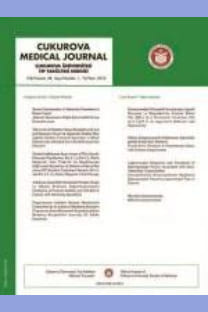Timokinonun izoproterenol ile indüklenen sıçan aortu üzerindeki sitoprotektif etkilerinin değerlendirilmesi
Isoproterenol, timokinon, aort.
Evaluation of the cytoprotective effects of thymoquinone on isoproterenol-induced rat aorta
Isoproterenol, thymoquinone, aorta.,
___
- 1. Sözen MA. Obezite ve obezitenin genetiği. Kocatepe Med J. 2006;7:1-11.
- 2. Tedik SE. Fazla kilo/obezitenin önlenmesinde ve sağlıklı yaşamın desteklenmesinde hemşirenin rolü. Turk J Diab Obes. 2017;2:54-62.
- 3. Altunkaynak BZ, Özbek E. Obezite: nedenleri ve tedavi seçenekleri. Van Med J. 2006;13:138-142.
- 4. Yanovski JA. Pediatric obesity. an introduction. Appetite. 2015;93:3-12.
- 5. Chesi A, Grant SFA. The genetics of pediatric obesity. Trends Endocrinol Metab. 2015;26:711-721.
- 6. Erkol A, Khorshid L. Obezite; predispozan faktörler ve sosyal boyutun değerlendirilmesi. SSK Tepecik Hast Derg. 2004;14:101-107.
- 7. Brown CL, Halvorson EE, Cohen GM, Lazorick S, Skelton JA. Addressing childhood obesity: opportunities for prevention. Pediatr Clin. 2015;62:1241–1261.
- 8. Stanik J, Kratzsch J, Landgraf K, Scheuermann K, Spielau U, Gausche R et al. Concordance of bioactive vs. total immunoreactive serum leptin levels in children with severe early onset obesity. PLoS One. 2017;12:e0178107.
- 9. Hyeong-Kyu P, Rexford SA. Physiology of leptin: energy homeostasis, neuroendocrine function and metabolism. Metabolism. 2015;64:24-34.
- 10. Münzberg H, Morrison CD. Structure, production and signaling of leptin. Metabolism. 2015;64:13–23.
- 11. Alamri NS, Hussain A, Alzein EH, Al Jareedan TW, Al Dawood M, & Hamad MA et al. Leptin as a potential biomarker for childhood obesity? EC Paediatrics. 2017;3:435-446.
- 12. Aslan K, Serdar Z, Tokullugil HA. Multifonksiyonel hormon: leptin. Uludağ Üniversitesi Tıp Dergisi. 2004;30:113-118.
- 13. Farr OM, Gavrieli A, Mantzoros CS. Leptin applications in 2015: What have we learned aboutleptin and obesity? Curr Opin Endocrinol Diabetes Obes. 2015;22:353–359.
- 14. Obradovic M, Sudar-Milovanovic E, Soskic S, Essack M, Arya S, Stewart AJ et al. Leptin and obesity: role and clinical implication. Front Endocrinol. 2021;12:585887.
- 15. Comba A, Mert H, Comba B. Leptin ve metabolik etkileri. YYU Veteriner Fakültesi Derg. 2014;25:87- 91.
- 16. Marcella A, Adriana Di Trana, Bernardo V, Andrea C,Salvatore B, Anna De A et al. Leptin gene polymorphism in goats fed with diet at different energy level: effects on feed intake, milk traits, milk fatty acids composition, and metabolic state. Animals (Basel). 2019;9:424.
- 17. Seth SM, Atif Q, Muredach PR. Leptin resistance a possible interface of inflammation and metabolism in obesity-related cardiovascular disease. J Am Coll Cardiol. 2008;52:1201-10.
- 18. Elias CF, Purohit D. Leptin signaling and circuits in puberty and fertility. Cell Mol Life Sci. 2013;70:841– 862.
- 19. Dias NF, Fernandes AE, de Melo ME, & Reinhardt HL, Cercato C, Villares SMF et al. Lack of mutations in the leptin receptor gene in severely obese children. Arq Bras Endocrinol Metabol. 2012;56:178-83.
- 20. Facey A, Dilworth L, Irving R. A Review of the leptin hormone and the association with obesity and diabetes mellitus. J Diabetes Metab. 2017,8:3.
- 21. Tam CS, Lecoultre V, Ravussin E. Novel strategy for the use of leptin for obesity therapy. Expert Opin Biol Ther. 2011;11:1677–1685.
- 22. Khosropour S, Shojaee M, Lotfi P. Obesity, leptin and leptin receptors. Gene Cell Tissue. 2016;3:e39980.
- 23. Catli G, Anik A, Tuhan HU, Kume T, Bober E, Abaci A. The relation of leptin and soluble leptin receptor levels with metabolic and clinical parameters in obese and healthy children. Peptides. 2014;56:72-76.
- 24. Huvenne H, Le Beyec J, Pépin D, Alili R, Kherchiche PP, Jeannic E et al. Seven novel deleterious LEPR mutations found in aarly-onset obesity: an exon6–8 shared by subjects from reunion island, France, suggests a founder effect. J Clin Endocrinol Metab. 2015;100: E757–E766.
- 25. Şahin S, Rüstemoğlu A, Tekcan A, Taşlıyurt T, Güven H, Yığıt S. Investigation of associations between obesity and LEP G2548A and LEPR 668A/G polymorphisms in a Turkish population. Dis Markers. 2013;35: 673–677.
- 26. Roszkowska-Gancarz M, Kurylowicz A, Polosak J, Mossakowska M, Franek E, Puzianowska-Kuźnicka M. Functional polymorphisms of the leptin and leptin receptor genes are associated with longevity and with the risk of myocardial infarction and of type 2 diabetes mellitus. Endokrynol Pol. 2014;65:11-6.
- 27. Angel-Chavez LI, Tene-Perez CE, & Castro E. Leptin receptor gene K656N polymorphism is associated with low body fat levels and elevated high-density cholesterol levels in Mexican children and adolescents. Endocr Res. 2012;124-34.
- 28. Mizuta E, Kokubo Y, Yamanaka I, Miyamoto Y, Okayama A, Yoshimasa Y et al. Leptin gene and leptin receptor gene polymorphisms are associated with sweet preference and obesity. Hypertens Res. 2008;31:1069–1077.
- 29. Oliveira R, Cerda A, Genvigir FDV, Sampaio MF, Armaganijan D, Bernik MMS et al. Leptin receptor gene polymorphisms are associated with adiposity and metabolic alterations in Brazilian individuals. Arq Bras Endocrinol Metabol. 2013;57:677-684.
- 30. Ma˘rginean CO, Ma˘rginean C, Voida˘zan S, Melit L, Crauciuc A, Duicu C et al. Correlations between leptin gene polymorphisms 223 A/G, 1019 G/A, 492 G/C, 976 C/A, and anthropometrical and biochemical parameters in children with obesity. Medicine (Baltimore). 2016;95:e3115.
- ISSN: 2602-3032
- Yayın Aralığı: 4
- Başlangıç: 1976
- Yayıncı: Çukurova Üniversitesi Tıp Fakültesi
Volkan GÖKBULUT, Ömer ÖZTÜRK, Meral AKDOĞAN KAYHAN, Mustafa KAPLAN, Sabite KACAR, Hale SÜMER, Püren GÖKBULUT, Derya ARI, Dilara TURAN GÖKÇE
Çağla AKINCI UYSAL, Meryem TEMİZ REŞİTOĞLU, Demet Sinem GÜDEN, Sefika Pınar ŞENOL, Özden VEZİR, Nehir SUCU, Bahar TUNÇTAN, Kafait U. MALİK, Seyhan FIRAT
Behçet hastalığında mukokutanöz lezyonlar mevsimsel midir?
Intussusepsiyon Henoch-Schonlein purpurası'nın ilk tezahürü olabilir mi?
İlknur SÜRÜCÜ KARA, Mustafa ÖZDAMAR, Abdulkerim KOLKIRAN, Necla AYDIN PEKER, İsmail TOPAL
Murat DAŞ, Okan BARDAKCI, Gökhan AKDUR, İmran KANKAYA, Coşkun BAKAR, Okhan AKDUR, Yavuz BEYAZIT
Eralp ÇEVİKKALP, Çağdaş BAYTAR
Elif AYDIN, Gülnur TARHAN, Funda ŞAHİN, Sami EREN
Multipl skleroz hastalarında nöropsikiyatrik bulguların incelenmesi
Ozge GONUL ONER, Ozlem TOTUK, İpek GUNGOR DOGAN, Didem CELİK, Serkan DEMİR
Baş boyun kanserlerinde hipoksi ve embriyonik kök hücre genlerinin rolü
Nermin Seda ILGAZ, Hale ÖKSÜZ, Mehmet Bertan YILMAZ, Nurşen KESER, Davut ALPTEKİN
